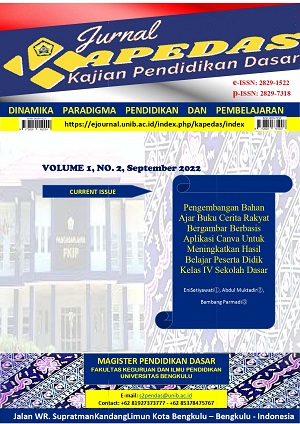Main Article Content
Abstract
Keywords
Article Details
Copyright (c) 2022 Fabil Fabil

This work is licensed under a Creative Commons Attribution-ShareAlike 4.0 International License.

Karya ini dilisensikan di bawah Creative Commons Attribution-ShareAlike 4.0 International License .
References
- Angriani, A.D., Mania, S., Alam, S., Rasyid, M.R., & Kusumayanti, A. (2021). Analysis of Final Exam Problems in Mathematics Semester of Junior High School. Alauddin Journal of Mathematics Education, 3 (1), 1-11.
- Anita, Tyowati, S., & Zuldafrial. (2018). Analisis Kualitas Butir Soal Fisika Kelas X Sekolah Menengah Atas. Jurnal Pendidikan, 16(1), 35–47.
- Arifin, Z. (2014). Penelitian Pendidika: Metode dan Paradigma Baru . Bandung: PT. Remaja Rosdakarya.
- BSNP. (2018). Buletin BSNP: Media Komunikasi dan Dialog Standar Pendidikan. Jakarta: BSNP.
- Cooper, J, M., Irizarry, J. G., & Leighton, M. S.. (2011). Classroom teaching
- skills 9 ed.). USA: Wadsworth, Cengage Learning.
- Febriyanti, E., Gustinova, W.A., & Walid, A. (2020). Analisis Instrumen Penilaian Tengah Semester IPA-FisikaKelas IX SMPN 09 Kota Bengkulu. DIFFRACTION: Journal for Physics Education and Applied Physics, 2 (2), 93-97.
- Halimah, L. (2017). Keterampilan Mengajar: Sebagai Inspirasi Untuk Menjadi Guru Yang Excellent Di Abad Ke-21. Bandung: PT. Refika Aditama.
- Kurniawan, T. (2015). Analisis Butir Soal Ulangan Akhir Semester Gasal Mata Pelajaran IPS Sekolah Dasar. Journal of Elementary Education, 4(4), 1–6.
- Sugiyono. (2020). Metode Penelitian Kuantitatif, Kualitatif, dan, R & D. Bandung: Alfabeta.
- Sugiyono. (2019). Metode Penelitian Pendidikan (Kuantitatif, Kualitatif, Kombinasi, R & D, dan Penelitian Pendidikan). Bandung: Alfabeta.
- Susanto, H., Rinaldi, A., & Novalia. (2015). Analisis Validitas Reabilitas Tingkat Kesukaran dan Daya Beda pada Butir Soal Ujian Akhir Semester Ganjil Mata Pelajaran Matematika. Jurnal Pendidikan Matematika, 6 (2), 203–217.
- Tarmizi, P., Setiono, P., Amaliyah, Y., & Agrian, A. (2020). Analisis Butir Soal Pilihan Ganda Tema Sehat itu Penting Kelas V SD Negeri 04 Kota Bengkulu. ELSE (Elementary School Education Journal). 4 (2), 124-132.
References
Angriani, A.D., Mania, S., Alam, S., Rasyid, M.R., & Kusumayanti, A. (2021). Analysis of Final Exam Problems in Mathematics Semester of Junior High School. Alauddin Journal of Mathematics Education, 3 (1), 1-11.
Anita, Tyowati, S., & Zuldafrial. (2018). Analisis Kualitas Butir Soal Fisika Kelas X Sekolah Menengah Atas. Jurnal Pendidikan, 16(1), 35–47.
Arifin, Z. (2014). Penelitian Pendidika: Metode dan Paradigma Baru . Bandung: PT. Remaja Rosdakarya.
BSNP. (2018). Buletin BSNP: Media Komunikasi dan Dialog Standar Pendidikan. Jakarta: BSNP.
Cooper, J, M., Irizarry, J. G., & Leighton, M. S.. (2011). Classroom teaching
skills 9 ed.). USA: Wadsworth, Cengage Learning.
Febriyanti, E., Gustinova, W.A., & Walid, A. (2020). Analisis Instrumen Penilaian Tengah Semester IPA-FisikaKelas IX SMPN 09 Kota Bengkulu. DIFFRACTION: Journal for Physics Education and Applied Physics, 2 (2), 93-97.
Halimah, L. (2017). Keterampilan Mengajar: Sebagai Inspirasi Untuk Menjadi Guru Yang Excellent Di Abad Ke-21. Bandung: PT. Refika Aditama.
Kurniawan, T. (2015). Analisis Butir Soal Ulangan Akhir Semester Gasal Mata Pelajaran IPS Sekolah Dasar. Journal of Elementary Education, 4(4), 1–6.
Sugiyono. (2020). Metode Penelitian Kuantitatif, Kualitatif, dan, R & D. Bandung: Alfabeta.
Sugiyono. (2019). Metode Penelitian Pendidikan (Kuantitatif, Kualitatif, Kombinasi, R & D, dan Penelitian Pendidikan). Bandung: Alfabeta.
Susanto, H., Rinaldi, A., & Novalia. (2015). Analisis Validitas Reabilitas Tingkat Kesukaran dan Daya Beda pada Butir Soal Ujian Akhir Semester Ganjil Mata Pelajaran Matematika. Jurnal Pendidikan Matematika, 6 (2), 203–217.
Tarmizi, P., Setiono, P., Amaliyah, Y., & Agrian, A. (2020). Analisis Butir Soal Pilihan Ganda Tema Sehat itu Penting Kelas V SD Negeri 04 Kota Bengkulu. ELSE (Elementary School Education Journal). 4 (2), 124-132.
